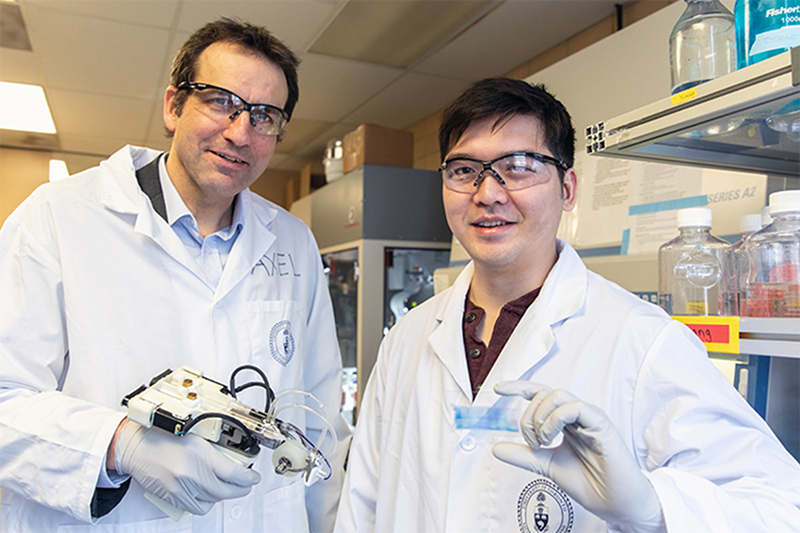In space — at least on Star Trek — no one can hear you apply a band-aid. That’s too low tech. When a Star Fleet officer gets an ouchie, the real or holographic doctor waves a dermal regenerator over the afflicted area, and new skin magically appears. Science fiction, huh? Maybe not. A group of scientists from Canada recently published a paper on a handheld instrument for depositing “skin precursor sheets” over full-thickness burns. The paper is behind a paywall and if you don’t know how to get it or don’t want to get it, you can see a video from the University of Toronto, below.
Although they use the term 3D printing, the device is more like a paint roller. Several substances merge together in the print head and lay down on the burn in broad stripes.
The machine is meant for people with full-thickness burns. These are burns that destroy both the outer and inner layers of your skin and often occur over very large areas. The team thinks the device could be in real use within five years. They have already gone through ten prototype designs.
Here’s a brief description of the machine from the paper:
The fibrin-based bioink is permissive for cell viability and proliferation and is cross-linked with a thrombin solution. The compact (20 cm × 11 cm × 15 cm) and light (1.4 kg) instrument is operated with one hand.
The operator holds the instrument on the handle such that the soft wheel to contacts the wound bed. Upon engaging the toggle switch, the wheel rotates at velocity V, guiding the deposition process. Simultaneously, the bioink and cross-linker stored on-board in separate syringes are co-delivered at the respective flow rates QB and QC. The solutions then pass through flexible
tubing to separate inlets of the microfluidic printhead that trails the wheel. Within the printhead, they are distributed through a bifurcated channel network towards a parallel array of microchannels at the exit that deposit a uniform thickness skin precursor sheet conformal to the wound bed, covered with the crosslinker.Because the widths of the printhead and deposited sheet exceed the width of the wheel, arbitrarily wide wounds can be covered by successive side-by-side sheet deposition. The deposited sheets are visually distinguishable from the wound immediately after leaving the printhead, allowing the user to adjust
the printhead position to ensure neighboring layers to be deposited without gap.
We have to admit that we spend more time thinking about robot skin. But we occasionally do think about bioprinting.
















Hi, sorry, French are already on this business with a working skin 3D printer ;)
https://poietis.com/
I always wondered why there wasn’t something like a fibreglass chopper gun, but shooting lanolin rich sheeps wool and antibiotic spider silk, with a hardening skin component.
Surely using an optical flow based vision sensor for adjusting the microfluidic flow rate and an aerosol or bubble-jet based non-contact application of the fibrin-bioink would be a better solution?
Speaking as someone who has been through the pain of 2nd and 3rd degree burns, the burnt skin region is highly sensitive and it makes me shudder just thinking of dragging the device across those areas…
Just because the term (aka academic catchphrase) ‘microfluidic’ is used does not necessarily make the device ground breaking, rather the bioink itself should be the focus of the article or work presented.
3rd degree or “full thickness” burns destroy the nerve endings and therefore don’t feel.
Have you ever had 3rd degree burns? Perhaps not would be my guess, think bout it carefully before posting from your armchair, 3rd degree burns are surrounded by, guess what… 2nd degree burns. But you must be the expert, with Wikipedia as your academic reference and life experience and all…
BTW, I had also mentioned the 2nd degree burns in the previous post too, or did you forget about that and just feel the need to troll?
I have (14% 3rd degree coverage + 5 large grafts), and really my memories of the event is that its relatively pain free. In fact the only bit that really really hurts is from the op where your skin was harvested for the graft because the donor zone itches like mad and is sore for months after. Just my actual experience, gallstones and having vas defrens removed under local for cancer checks were both far far more painful a experience.
Yeah parent is a idiot, but its better to come from a angle of actual experience and be right when dismissing same.
He didn’t say burn victims aren’t in pain jackass. Sorry you got burned, but it doesn’t give you the right to be an arsehole
@Naxes gotta diasgree with you there bud, “…therefore don’t feel” implies no pain
@naxes wow two insults in the one post… but Paul did mention pain/feel so I guess the doc might have you there
@none sorry you got burned too fella, the vas thing sounds nasty but prolly better to safe than end up with old Jack the dancer. You lost me at the parent is an idiot, but like you it appears the doc was speaking from personal experience also
Personally I’ve had some major burns from both lab grade acids and a mishap with an industrial smelter where I used to work, neither felt nice and the latter almost resulted in losing a leg, the wort part apart from the pain was the smell of cauterised me. Spent a good couple of months in hospital and a few more in physical rehab after that one. The grafts still give me grief at times
What rock have these guys been under? Already been done, and better, with a non-contact application of skin stem cells from the burned person’s own skin. https://www.youtube.com/watch?v=eXO_ApjKPaI
Perfect for covering up those unsightly metal surfaces of any symbiont.